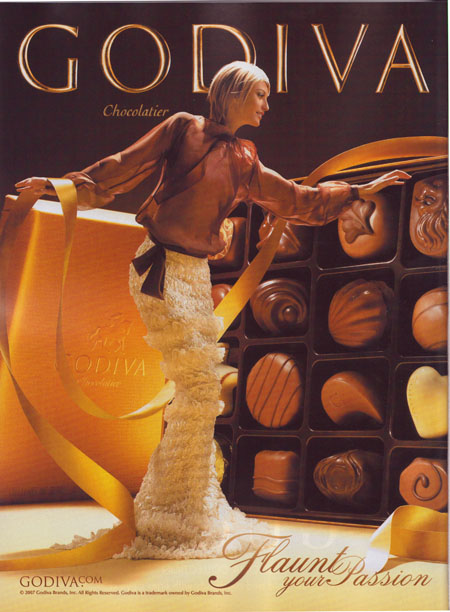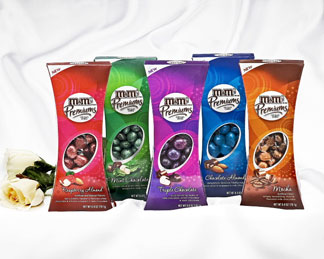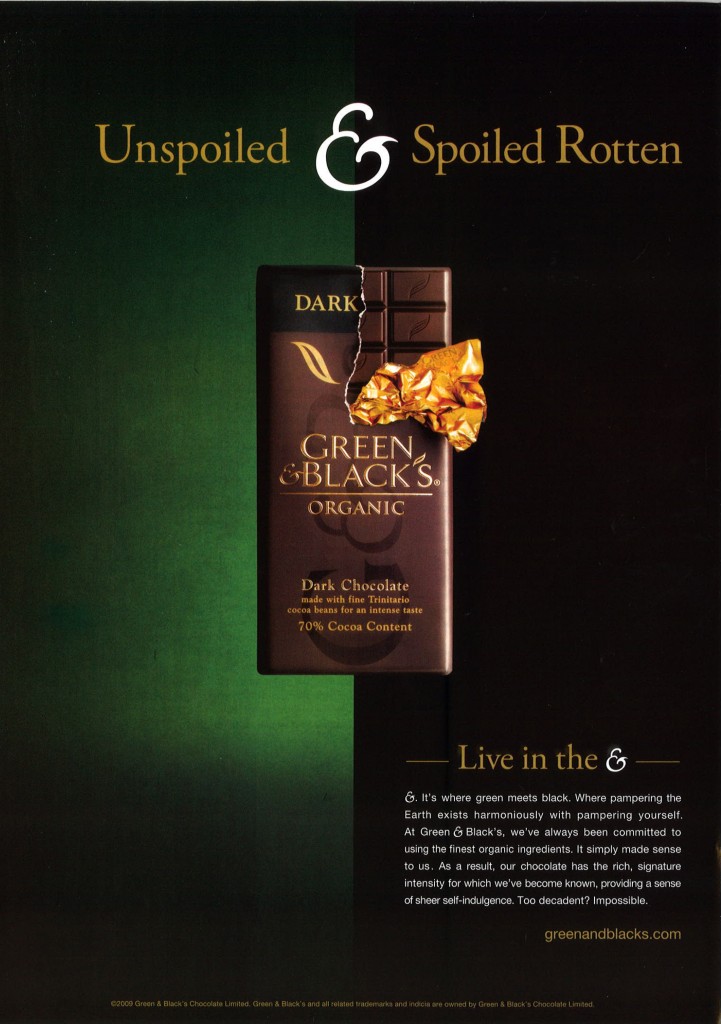In consumer society, products sell an image of the consumer to others. Chocolate, for example, can bring prestige if it comes from a particular manufacturer and falls within a certain price range. The design and ideology behind Godiva for example, promotes a sophisticated chocolate and uses powerful imagery to convince consumers that they may attain an unparalleled experience of high-class luxury.
Godiva promotes the idea that consumers of their chocolates are somehow “higher class” and more “tasteful” than people who do not consume them. As a result, their chocolates have a higher exchange value than the everyday, $1 chocolates meant for middle and lower-class consumers.
Many chocolate connoisseurs argue that Godiva chocolates taste like sugar and candle wax, failing to satisfy the European taste criteria for elite chocolate. Nevertheless, the reputation of Godiva as luxurious is enough to satisfy many non-connoisseurs and it, accordingly, maintains a high exchange-value. Hoping to capitalize on the trend, many popular brands have released their own line of “premium” chocolates hoping to reap profits far out of proportion to the cost of production.
From a Marxist viewpoint, status-symbol chocolate advertising exemplifies how fetishization helps maintain capitalism. Such advertising tacitly legitimizes the elite class by reinforcing the image of upper-class superiority and by presenting the luxurious lifestyle as something to aspire to. It also helps foster false consciousness, which lulls the oppressed working class into complicity, even or especially when prices for “premium” chocolates fall suspiciously low.
Is fair trade a resolution to chocolate’s fetishism?
Chocolate’s fetishism is partially resolved through Fair Trade, which redistributes some of those profits back to the working class and makes the consumer conscious of the worker.
The fetishism of chocolate is only partly resolved, however, since the owning class continues to profit from the fetishism of the commodity and from the enhancing status of the “Fair Trade” label. The purchasing of Fair Trade chocolate, you see, provides the consumer with some emotional comfort; it flatters them just as a high end chocolate product flatters buyers who identify themselves as elite. Therefore, there is an increase in the consumer’s cultural capital with the purchase of Fair Trade chocolate. It is still fetishism to the extent that the consumer is purchasing a comforting emotion or an image of themselves saving the world, which is encouraged by advertising campaigns and wrapper designs. However, in an interesting twist, fetishism is used to reverse the effects that it is traditionally guilty of: benefiting the upper-class at the expense of the lower-class.
————————-
Jamal Fahim graduated from Occidental College in 2010 with a major in Sociology and a minor in Film and Media Studies. He was a member and captain of the Occidental Men’s Tennis team. Jamal currently lives in Los Angeles with the intention of working in the film industry as a producer. His interests include film, music, digital design, anime, Japanese culture, improvising, acting, and of course, chocolate!
If you would like to write a post for Sociological Images, please see our Guidelines for Guest Bloggers.
Lisa Wade, PhD is an Associate Professor at Tulane University. She is the author of American Hookup, a book about college sexual culture; a textbook about gender; and a forthcoming introductory text: Terrible Magnificent Sociology. You can follow her on Twitter and Instagram.



Comments 49
Terrie — November 15, 2010
It's worth noting that many fair trade brands of chocolate are also of higher quality.
Sue — November 15, 2010
"It is still fetishism to the extent that the consumer is purchasing a comforting emotion or an image of themselves saving the world..."
--I don't think most consumers are that self-deluding; Fair Trade chocolates allow them to enjoy a treat with the knowledge that the conditions under which it was produced are a bit more fair than usual.
--I also suspect that the new "premium" lines of the other chocolate manufacturers are in fact better than the usual product. They're also not just competing with Godiva, but with the many brands of quality chocolate that have been introduced into the market over the last 20 years.
--Although having the aspirational quality of a product is usually exploited by companies (apparently cigarettes didn't take off with women until companies ran ads of pretty, elite young women smoking)*, the public, or at least the serious chocolate-consuming public, has become more educated about chocolate and is more demanding.
*I learned this while watching a documentary about advertising called "The Century of the Self."
different anon — November 15, 2010
I think part of the problem with godiva being upper class chocolate while not being all that good is that most american chocolate is AWFUL.
A german lab-mate of mine once purchased a hershey's bar, came back to the lab and nearly choked when she tasted it. It was actually pretty funny to see her amazement that people EAT this stuff. The other germans in the lab had the same reaction.
Americans don't really eat chocolate. We eat chocolate AND stuff. With caramel, with peanut butter, with nougat, with hard sugar coatings, ect, and because chocolate is sort of an accessory taste, it doesn't need to be good chocolate.
So, even if godiva isn't all that great, it's better than the more common american chocolates, and so it still seems like a huge step up in comparison and seems worth the price.
Lance — November 15, 2010
What's amusing is that Godiva has started running commercials that say (paraphrasing slightly): "We Belgians are led to understand that Americans save Godiva for special occasions. But Godiva should be shared, not saved!" For the most part it struck me as a less-veiled-than-usual way of saying "buy more of our product", but it has an interesting interaction with the point made about Godiva here.
Ben — November 15, 2010
From a Bourdieuian perspective, you could also argue that the chocolate connoisseurs need to say that Godiva is terrible in order to preserve their own cultural status as connoisseurs. If the middle-class can access high-quality chocolate without having to pay for the ultra-expensive stuff, the cultural capital of the connoisseurs is diminished.
SaintPeter — November 15, 2010
I have only one question: Why is the "high class" lady in the first image wearing my bathroom throw rug around her legs?
Emma — November 15, 2010
Well, I am a wee bit confused about the particular use of the Marxist terminology:
"From a Marxist viewpoint, status-symbol chocolate advertising exemplifies how fetishization helps maintain capitalism. Such advertising tacitly legitimizes the elite class by reinforcing the image of upper-class superiority and by presenting the luxurious lifestyle as something to aspire to."
The thing is, this is not at all what Marx was talking about when he keyed the concept of commodity fetishism. It wasn't about images, desire for certain goods or markings of the upper-class, but a description of a phenomenon in so-called 'advanced stage in capitalist societies'. Commodity fetishism means that the social productive relations between people get mystified, so that people start to believe that commodities get created by other commodities, without paying attention to the human labour, which according to Marx is the fundamental source of value. It's about believing that commodities have their own life, or that their value is reflective upon relations between material stuff and people, rather than between people.
Now, I am all for upgrading traditional sociological and political concepts, but I can't remember to have encountered this reading of commodity fetishism before, and it seems to at least partly conflate this theory with the more colloquial understanding of 'fetish' as desire. i would argue that the analysis is resting much more on classical Bourdieu, with his idea that class disctions also get created in the social sphere of consumption, which Marx would probably have rejected.
kinelfire — November 15, 2010
It's faintly amusing that the author chose Green & Black's to demonstrate the Fair Trade, luxury chocolate.
They were an independent company until 2005 when they were bought over by Cabury's, who were in turn swallowed by Kraft very recently. Being bought by Cadbury's allowed G&B to expand their use of Fair Trade chocolate to more products, rather than just one. There may be something worth expanding there, about how Fair Trade is used as a marketing tool that means very little in some cases, but that is off-topic and I'd too tired just now.
Divine Chocolate, though. That is all kinds of lovely, in my opinion.
kelly — November 16, 2010
our factory is specified in making food machinery. and now we have different kinds of chocolate fountain machineries.if you are intresated in them and want more informations of our factory ,pls mail to zhejiangyy@yahoo.com or call nomber:86057113867102082
Inny — November 17, 2010
c'ote d'or an elite chocolate?
Try ferrero rocher. Extremely tasteful and not even 'really' that luxurious.
Who Picks the Cacoa for Your Chocolate? « The Augmented Environment — June 28, 2012
[...] between the producer and consumer.” Chocolate is always a luxury, of course (and is often deliberately marketed this way), and the product, at its finest, can be exceptionally delicious and exceptionally [...]
Gestern — October 27, 2021
Chocolate used to be a luxury, am I wrong? I think that even today, people don't eat high-quality good chocolate because they prefer to buy something cheap. But a bar of good chocolate is not expensive at all, and I think that most people can afford organic chocolate gifts to their friends and family members.
bafolep — May 30, 2022
Wondering how to log into the orbi router? Using orbilogin.net, it is easier to sign into orbi device. If orbilogin.net fails to connect, make sure you are connected to the orbi network. Switch to the wired connection if you are connected via wireless connection. For more such tips, give us a call.
www.mywifiext.net Login — October 31, 2022
This can be the web address next to running your Wi-Fi extension. This page allows you to manage various aspects of the extension. By going here, you will install an extension that is not used easily. Once you access the www.mywifiext.net interface in a web program (Firefox, Chrome, etc.), you can be prompted for a gear registration report. It requires login credentials, for example, username and password.
ORBILOGIN.COM — November 2, 2022
Accessing Orbilogin.com is easy. It is a platform that allows you to browse your router. So, first check if your router is compatible with Orbilogin.com. They will not work with all routers. Then you have to go to orbilogin.com and enter your credentials.
Ron — December 17, 2022
To Verizon router login launch an internet browser and type the Verizon Fios router login IP address i.e., 192.168.1.1. Now, the Verizon router login page will appear on your screen. Carefully, enter the Verizon Fios router login password and username. Lastly, you will be logged in.
Jack — December 22, 2022
The Ring Camera login page allows you to access your smart home security camera. It is important to access your Ring camera in order to be able to modify or manage its wireless settings. The Ring camera login allows you to get inside your camera and perform the changes as per your requirements or liking.
Saqib — January 22, 2023
NTS Result have the same importance and value for the candidates as any other result. NTS stands for National Testing Service. National Testing Service is a nationwide institution established in 2006 to conduct NTS test for different purposes.
Austin — May 8, 2023
How To Change Verizon WiFi Password is a simple process that involves logging in to the Verizon router's web-based interface using the default web address, such as 192.168.1.1 or 192.168.0.1, and accessing the wireless settings. From there, users can navigate to the security or wireless settings section, select the option to change the WiFi password, and save the new password.
Orbi blinking white light — May 30, 2023
However, there are times when users struggle to take advantage of their mesh WiFi systems due to the Netgear Orbi blinking white light issue.
Routerlogin — September 12, 2023
You will be taken to the BASIC Home screen or the Status page of the router where the router’s Internet, WiFi, Network Map, Parental Controls, ReadySHARE tabs and other settings will appear netgear router login
Asutin — November 7, 2023
If you're trying to find help with the Linksys Velop not working issue, firstly check with the power supply on it. Also, find that the power light gets turned on for your Linksys Velop. If still get stuck with issues, call us now!
Jhone Martin — November 28, 2023
You must set up the Linksys smart WiFi router properly before you start using it. To set up the router, you must log into the router’s web interface. For the login, you can use the linksyssmartwifi.com address. Using this address, you can set up the router accurately. But you can check out our website if you are facing issues while trying to resolve your Linksys router.
zoeywilson — February 20, 2024
You can easily access your TP-Link router’s account by accessing the user admin dashboard. To proceed, open a web browser, enter the tplinkwifi.net Login address in the browser’s URL bar, and fill in the admin login credentials in the required fields. To learn the complete TP-Link login process, visit our website now!